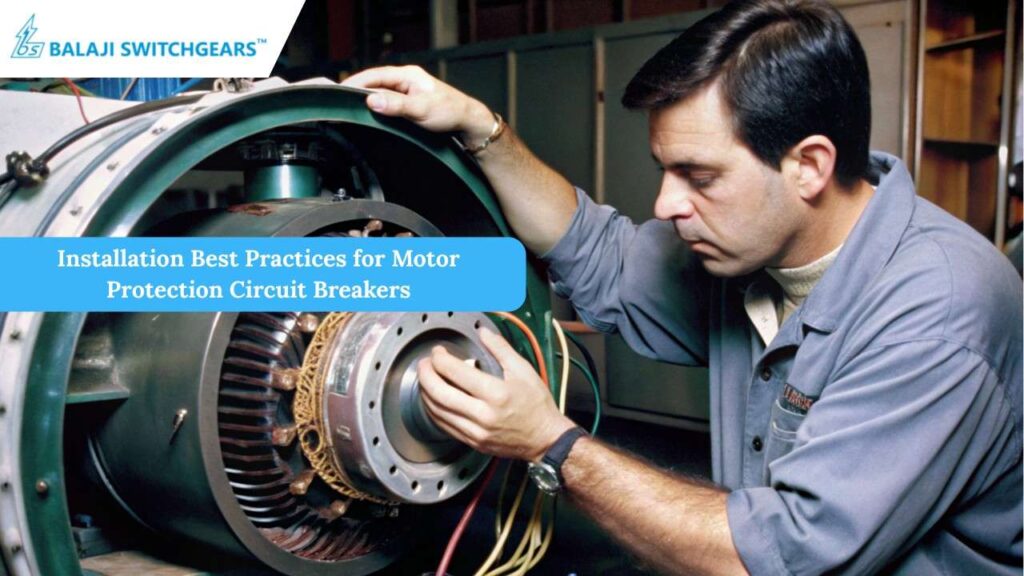Motor Protection Circuit Breakers (MPCBs) play a critical role in safeguarding electric motors from overloads, short circuits, and phase failures. They are an essential component in industrial automation, manufacturing setups, and commercial applications. Installing MPCBs correctly ensures safety, system reliability, and extended motor life.
In this blog, we’ll discuss the best practices for MPCB installation, highlight important considerations, and provide tips for both panel builders and electrical professionals.
Understanding Motor Protection Circuit Breakers
A Motor Protection Circuit Breaker is a device designed to protect motors from abnormal operating conditions. Unlike standard circuit breakers, MPCBs are specifically tailored to handle motor starting currents, overload conditions, and short circuits. Key functions include:
- Overload Protection – Prevents motor overheating due to excessive current.
- Short-Circuit Protection – Trips the motor in case of sudden high current.
- Phase Failure Protection – Ensures the motor does not operate under an unbalanced phase.
- Manual Switching – Allows safe manual operation and maintenance.
MPCBs are commonly used for induction motors in industrial machinery, pumps, compressors, and HVAC systems.
Key Considerations Before Installation
Before installing Motor Protection Circuit Breakers, consider the following:
1. Correct Rating Selection
- Current Rating: Select an MPCB rated slightly above the motor’s full-load current to prevent nuisance tripping during startup.
- Voltage Rating: Ensure the breaker voltage matches or exceeds the system voltage.
- Breaking Capacity: Verify that the MPCB can safely interrupt fault currents.
Choosing the correct rating is critical. An undersized MPCB can trip frequently, while an oversized breaker may fail to protect the motor.
2. Environment and Panel Design
The installation environment impacts the performance of MPCBs:
- Ambient Temperature: MPCBs are calibrated for a specific temperature range (usually 20–40°C). High temperatures may require derating.
- Humidity & Dust: Enclosures should have adequate IP rating to protect against dust, moisture, or corrosive atmospheres.
- Vibration: Motors in heavy machinery may experience vibration; mount MPCBs securely to avoid loosening connections.
3. Proper Mounting and Panel Layout
For reliable operation:
- Mount MPCBs vertically to ensure proper heat dissipation.
- Maintain adequate spacing between devices for heat and airflow.
- Ensure accessibility for manual operation, testing, and maintenance.
- Use DIN rails or panel mounts compatible with the MPCB model.
Well-planned panel layout reduces installation errors, prevents overheating, and improves maintenance efficiency.
4. Correct Wiring Practices
Proper wiring is crucial for MPCB reliability:
- Use conductors of correct gauge to match the breaker’s current rating.
- Tighten connections to the manufacturer’s recommended torque to prevent loose contacts.
- Keep wires organized using wire ducts, cable ties, or trays to prevent tangling and reduce electromagnetic interference.
- Separate control and power wiring to avoid noise and signal interference.
5. Coordination with Other Protective Devices
MPCBs often work alongside other protective devices like fuses, overload relays, or upstream breakers. Proper coordination ensures:
- Selective Tripping: Only the affected circuit trips during a fault.
- Reduced Downtime: Prevents unnecessary shutdown of other systems.
- Enhanced Safety: Maintains proper motor protection while protecting the overall electrical system.
6. Phase Sequence and Protection
Motors may be damaged if the phase sequence is incorrect:
- Verify proper phase rotation before connecting the motor to the MPCB.
- Use phase failure relays or integrated MPCBs with phase protection for sensitive applications.
7. Grounding and Earthing
Grounding is essential for safety and proper operation:
- Connect the motor frame, panel, and MPCB metal parts to the system ground.
- Ensure low-resistance earth connections to prevent electrical shock hazards.
8. Functional Testing
After installation:
- Conduct manual operation tests to ensure smooth ON/OFF operation.
- Perform trip tests at different loads to confirm proper functioning.
- Verify the motor starts and stops as expected under normal and fault conditions.
Functional testing ensures the MPCB operates reliably during real fault conditions.
9. Labeling and Documentation
For easy maintenance and troubleshooting:
- Label the MPCB with motor designation, rating, and trip characteristics.
- Keep wiring diagrams, datasheets, and instruction manuals accessible.
- Document any changes in the wiring or panel layout.
10. Regular Inspection and Maintenance
Periodic maintenance enhances the life of both the motor and MPCB:
- Inspect connections for tightness and corrosion.
- Check for dust or moisture accumulation in enclosures.
- Verify the MPCB trip characteristics periodically.
- Replace worn or damaged devices promptly.
Regular maintenance prevents unexpected failures and reduces downtime.
Common Mistakes to Avoid
- Installing an undersized breaker, leading to nuisance tripping.
- Ignoring manufacturer-recommended torque settings for connections.
- Crowding multiple MPCBs without proper spacing.
- Skipping functional testing after installation.
- Overlooking grounding requirements.
Avoiding these mistakes ensures optimal protection and operational efficiency.
Advantages of Properly Installed MPCBs
- Enhanced Motor Life: Correct protection prevents overheating and mechanical damage.
- Improved Safety: Reduces the risk of fire, electric shock, and system failures.
- Reduced Downtime: Proper installation and coordination minimize unplanned shutdowns.
- Compliance: Meets industry standards and regulations for motor protection.
Selecting the Right MPCB Supplier
Choosing a reliable MPCB supplier ensures quality products, technical support, and compliance:
- Look for authorized distributors of top brands such as Schneider Electric, Siemens, or ABB.
- Verify supplier expertise in industrial applications and panel wiring.
- Ensure availability of technical documentation, spares, and after-sales support.
For example, Balaji Switchgears is an authorized supplier offering expert guidance on Motor Protection Circuit Breakers, helping industrial professionals choose the right solutions.
Conclusion
Installing Motor Protection Circuit Breakers correctly is critical for protecting motors, ensuring operational efficiency, and enhancing workplace safety. By following best practices such as selecting the right rating, proper wiring, spacing, grounding, functional testing, and maintenance, industrial professionals can maximize motor lifespan and reduce downtime.
Partnering with a trusted MPCB supplier like Balaji Switchgears ensures access to high-quality devices, technical support, and reliable solutions tailored to your applications. Efficient installation today translates to safer and more productive operations tomorrow.

